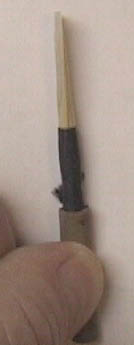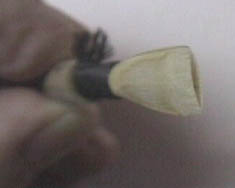The Oboe
The oboe, the soprano member of the orchestral double reed family, is known for its distinctive tone color and expressive quality. The oboe has a narrow conical bore [1] with a flaring bell and a double reed mouthpiece made of opposing arc-shaped blades that beat together when producing a tone. A conical bore (unlike the cylindrical bore of the clarinet) allows for the production of every harmonic, contributing to the oboe's rich tone. From reed tip to bell, the modern oboe measures approximately 62 centimeters. The playing compass ranges from Bb3 (233 Hz) to A6 (1760 Hz).[2]
Close relatives of the oboe, sharing the same fingering system and reading the same clef, but having a bulb-shaped rather than a flaring bell, include the oboe d'amore (pitched in A, a minor 3rd lower than the oboe), the English horn or cor anglais (pitched in F, a fifth lower than the oboe) and the baritone oboe, also known as the bass oboe (pitched one octave below the oboe). The English horn is a regular member of the modern symphonic orchestra, the other two siblings are much less frequently heard there.[3] The bassoon is a bass member of the orchestral double reed family, but more a cousin than a sibling, as it has different bore and keyhole ratios, and a significantly different fingering system.
The breath pressure required to play oboe is considerable, ranging from 25 mmHG to as much as or over 90 mmHG. Notes that are either louder or in the upper register of the oboe require more pressure than those that are quieter or are pitched in a lower register. In comparison, the breath pressure required to play a clarinet typically ranges from 15 mmHG to a little under 45 mmHG.[4] The opening of the reed is small, typically measuring in the vicinity of 4 2/3 mm2 when at rest, though some oboists prefer reeds that are either more or less open than this.[5] As a consequence of the small aperture, and despite the high pressure used to play, very little air passes through the reed, and oboists often find themselves needing to exhale stale air prior to taking in a new breath.[6]
Changes to either the air pressure or the reed opening size (which can be altered via the embouchure), affect volume, pitch, and timbre.[7] Because of this, learning to coordinate embouchure with breath is a key skill. One of the exercises commonly used to develop this skill is the deceptively simple task of playing a note that slowly ranges from pp to ff and back while keeping the pitch steady. This practice of playing long tones also helps the oboist develop strength and endurance.[8]
The oboe reed serves as a valve, modulating the flow of air into a series of puffs. When these puffs coordinate with the standing pressure waves within the bore, continuous tones are maintained.[9] The pressure changes that result and radiate from the oboe constitute the sound that we hear. The degree of difference between the high and low pressure points in the cycle correlates to the perceived loudness. The time taken for the wave to travel from the reed to the first open key holes or bell, in combination with pitch-related properties of the reed and how it is being blown, gives us the frequency of the note. The shape of the emitted wave translates to the perceived tone, e.g., wave patterns that transition abruptly between low and high peaks will have higher frequency content than patterns that are smoother or more sinusoidal.
Frequency content of about 1.5 kHz and below radiates mostly out of the first two open tone holes, and to a gradually lesser extent from the remaining open tone holes. Higher frequencies radiate from all the tone holes and the bell, and in general are more directional than the lower frequencies.[10] The oboe bore's walls primarily serve as a rigid container for the standing waves, unlike a violin where the body walls are intentionally set into vibratory motion (see wood resonance).[11] Thus, when the player stops a note, the sound immediately stops, unlike an instrument with a resonant sounding box that decays gradually.[12] The air pressure waves within the bore are longitudinal, moving from end to end, rather than latitudinal, moving side-to-side as with a violin string. The pressure variations are greatest at the reed (pressure antinode) and at a minimum just outside the open tone holes (pressure node). The longitudinal standing wave interacts with the reed to lock it into a frequency that is a function of both the length of the bore and pitch-related properties of the reed.[13]
Variations in the bore shape and in the size and undercutting of the tone holes affect not just pitch and volume, but tone color and response as well. Benade (1990/1976, p. 449) describes how the different tone hole sizes and shapes result in a cutoff frequency which relates to the brightness or darkness of the tone color. He places the cutoff frequency for the oboe, with its relatively small tone holes, at about 1.5 kHz.
The body material must be strong enough to support an elaborate keywork, and able to resist warping or cracking.[14] Of currently used materials, Grenadilla (Dalbergia melanoxylon), and plastic are the most common. Other options include Violetwood, Rosewood, and composites of ground grenadilla in resin, as well as the combination of wood with a plastic inner lining. A metal oboe was made in the early 1800's with a thin wall and built up tone hole cylinders, but the tone was considered inferior and production was abandoned (Burgess & Haynes, 2004, p. 143).
There are differences ascribed to the different materials. However, the effect of wall materials in general, and the plastic versus wood question in particular, is not settled science. The superior sound commonly ascribed to wood over plastic oboes may reflect the particular bore and keyhole dimensions of the models being compared rather than inherent acoustic properties of plastic. For example, Loree (maker of the majority of oboes used in U.S. orchestras today) offers a plastic top joint that most consider to be on a par with its wood top joint.[15]
Notes
[1] "The conical semiangle for an oboe is small, typically only about 0.7 degrees..." (Fletcher & Rossing, 1998, p. 493).
[2] Some oboes are fitted with an extension or keywork that allows low A3. A6 is the highest note that is playable with normal embouchure technique. A few higher notes can be obtained by putting the teeth on the reed in combination with special fingerings (Goosens & Roxburgh, 1993, pp. 168-169).
[3] See "The extended oboe family" (Burgess & Haynes, 2004, pp. 183-191).
[4] These figures (converted from kPA to mmHG) come from Fig. 15.9 in (Fletcher & Rossing, 1997, p. 483) which in turn cites data from a paper of Fuks & Sundberg from 1996. It is possible, of course, with a particularly stiff reed, to blow even harder, but at some point one reaches systolic blood pressure, and fainting becomes the likeliest outcome.
[5] This estimate was obtained by measuring a number of commercial and home-made reeds. A reed is typically about 7 mm wide or slightly less, and has a separation of about 1 mm at the most open point. Both width and opening size preferences vary for different players. For a rectangle circumcising a narrow arc of a circle, the area inside the arc is approximately 2/3rds the size of the rectangle (Nederveen, 1998, p.41). Thus for the two blades we have 2 * 0.5 mm * 7 mm * (2/3)) = 4 2/3 mm^2.
[6] This issue is discussed maybe most famously by Joseph Robinson (1996/1987) in his article "Oboists, Exhale Before Playing!" R. J. Koch (1990, pp. 5-24) devotes an entire section of an etude book to a series of progressive breathing exercises with separately designated spots for inhaling and exhaling.
[7] Marcel Tabuteau was one of the most influential oboists in America. His students and students' students continue to dominate the profession. His teachings on the interrelationship of pitch, volume, breath and embouchure are summarized by Joseph Robinson (1996/1987). Useful additional material on this theme can be found written by Arthur Weisberg (2007/1993, pp. 3-15), and David Ledet (2000/1981, p.30). A more formal, physics-oriented description of the effect of "a tighter clamping of the reed" can be found in Nederveen (1998, p. 35).
[8] Examples in oboe pedagogy include Schuring (2009, pp. 76-77) and an essay by Jay Light (1994, pp. 35-43) titled: "Long Tones - Milk for Oboists; You Never Outgrow Your Need For It."
[9] Paraphrasing Benade (1990/1976, p. 430) and Nederveen (1998/1969, p. 29).
[10] See section 15.5 "Directionality" (Fletcher & Rossing, 1998, pp. 480-481). One implication is the resulting importance of reflective surfaces in a reverberant space that allow the various frequency components of the tone to blend together for the listener.
[11] Nederveen (1998, p. 94) writes that the walls do vibrate, but at a very low level: 40dB (10,000 times) less energy radiates from the walls than from the bell and open tone holes.
[12] An important technique for oboists (and other winds) is the ability to mimic sounding box resonances. A resonant-sounding taper, for example, can be executed with a slight constriction of the embouchure combined with a lessening of air pressure just prior to closing off the note (Weisberg, 2007/1993, pp. 33-45).
[13] The oboe bore is a truncated cone. Benade (1990/1976, p. 469-470) writes "If the total air column is to have properly placed resonances for setting up good regimes of oscillation, it must have at least the overall behavior of a conical air column." Both Benade and Nederveen (1998/1969, p. 41) point out that the cavity within the oboe reed is too small to account for the missing apex section of the cone. Each refers to the reed as functionally substituting for this missing section. The size of the "fictitious cavity" that is mimicked by the reed is dependent not only upon the space within the reed, but on mechanical factors such as the distance that the blades must travel to close, blowing pressure, and the strength, resilience and damping properties of the cane blades.
[14] While cracking remains a hazard with grenadilla and other woods, the technology for repairing cracks has advanced significantly, and is no longer considered an automatic "death blow" for an oboe.
[15] Nederveen (1998, pp. 94-95, 134) acknowledges that different materials may have different vibrational patterns which could, possibly, impact tone and response. Certainly, many top-level musicians, and instrument makers, claim that there are differences based upon materials. But a scientific model has not yet been made that adequately explains all the reported perceptions.
Bibliography
Benade, A. H. (1990). Fundamentals of Musical Acoustics, Second, Revised Edition. New York, NY: Dover Publications, Inc. (Original work published 1976).
Burgess, G., & Haynes, B. (2004). The Oboe. New Haven, CT, and London, UK.: Yale University Press.
Fletcher, N. H., & Rossing, T. D. (1998). The Physics of Musical Instruments, 2nd Edition. New York, NY: Springer Science+Business Media, Inc.
Goosens, L., & Roxburgh, E. (1993). Yehudi Menuhin Music Guides: Oboe. London, UK.: Kahn & Averill.
Koch, R. J. (1990). Technik des Oboenspiels: The Technique of Oboe Playing. Mainz, Germany: Schott.
Ledet, D. A. (2000). Oboe Reed Styles, Theory and Practice. Bloomington, IN: Indiana University Press. (Original work published 1981).
Light, J. (1994). Essays for Oboists. Fort Myers, FL: Alborada Publications.
Nederveen, C. J. (1998). Acoustical Aspects of Woodwind Instruments, Revised Edition. DeKalb, IL: Northern Illinois University Press. (Original work published 1969).
Robinson, J. (1996). Oboists, Exhale Before Playing, The Double Reed, Vol. 19, No. 3, International Double Reed Society (Original paper published in DR 10, #3, 1987, pp. 16-19).
Schuring, M. (2009). Oboe, Art & Method. New York, NY: Oxford University Press.
Weisberg, A. (2007). The Art of Wind Playing. Delray Beach, FL: Meredith Music. (Original work published 1993).
|
Index
Woodwind instruments
Musical instruments |


